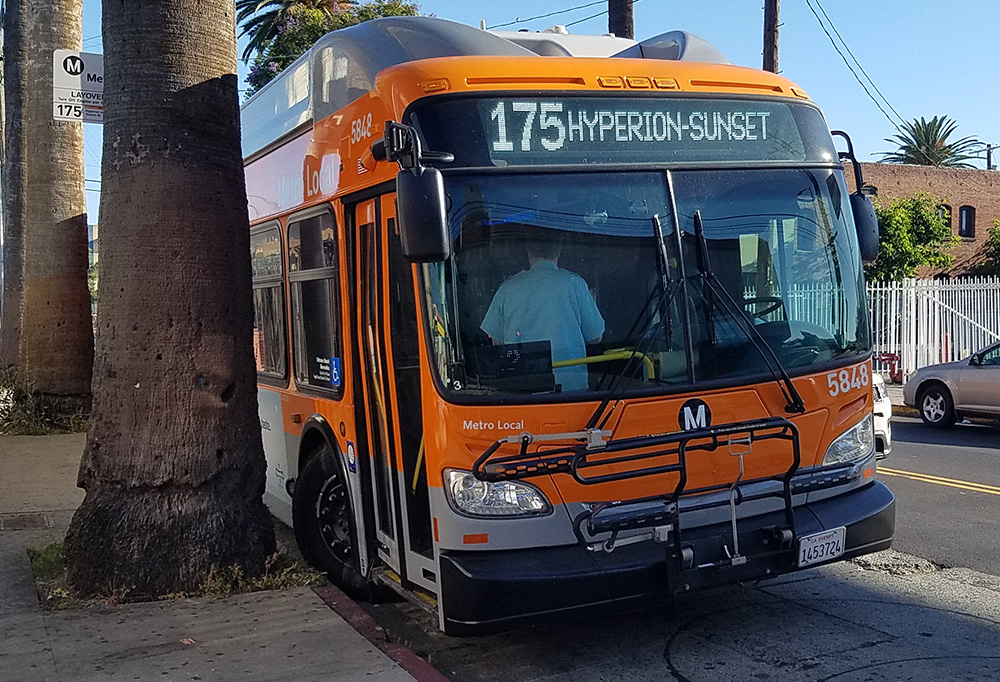On Sunday, June 27, Metro implemented the second phase of its NextGen bus system revamp – affecting some 88 bus routes. But 26 of those lines were gone forever, including one in particular: Line 175.
In September 1983, I started junior high school. Coming from an elementary school that was a four-block walk from home, it was now time to enter The Real World. Mom didn’t drive, and dad’s work commute went in another direction, so I had to find a way to get to school. I had to ride…The Bus.
Having been born and raised within the 27-year period where Los Angeles was devoid of rail transit (i.e. The Dark Ages), The Bus was all we had. And in The Dark Ages, the car was truly king, much more so than it is today, when transit has far less stigma. Before it became Metro, the Southern California Rapid Transit District, a.k.a. the RTD, was our transit system. It wasn’t rapid; it was “Rough, Tough and Dirty” - but it was all we had.
Getting to school involved riding one bus line – the 175, which ran primarily down Fountain Avenue and stopped within a block of Thomas Starr King Junior High. This was my first time ever riding The Bus – a twice-daily routine of popping two quarters into the vertical glass farebox, soon replaced by obtaining an RTD student bus pass – which cost a whopping four dollars for a monthly sticker.

As far as Metro Local bus lines go, 175 was a modest one: A route stretching all but five and a half miles from St. Andrews Place and Santa Monica Boulevard in Hollywood to Sanborn Avenue and Sunset Boulevard in Silver Lake. Running through mostly residential territory, its primary purpose was to shuttle students to and from John Marshall High School in Los Feliz, as well as nearby King Junior High (now Middle) School, running within the schools’ western boundary areas. Its ridership and service frequency was light and sparse, except during the 7:00 a.m. and 3:00 p.m. hours, when junior and senior high students crammed the buses like cattle. By the time the bus arrived at my regular stop at Edgemont Street and Fountain Avenue in what is now East Hollywood, it was rare to find an empty seat.
Line 175 was created in 1981 when the RTD did its own NextGen-type system update and replaced its hodgepodge line numbering system created by legacy transit operators with one that reflected direction and service type. Being a line that ran primarily east-west that did not serve downtown, 175 was placed in the 100-199 line category. But the line had roots going back as far as 1923 when the Pacific Electric Railway ran connecting bus routes along Hyperion Avenue, which extended west in 1932 to Talmadge Street to serve the newly-built Marshall High during the L.A. Motor Coach era. In 1958, operated by the old Los Angeles Metropolitan Transit Authority, the line was known as Line 78, an identity it retained until the RTD’s early 1980s-era renumbering.
The last incarnation of 175 only ran a weekday schedule, so Friday, June 25 became its final day of service. I decided, for old time’s sake, and to honor the line that played a huge part of my life for six years, to ride it from end to end, for the very last time.

When I was an eleven year-old first-time bus rider, the world was much smaller – being only school and wherever my parents took me, yet the neighborhood seemed much bigger. Little 11 year-old me staring impatiently down Fountain would spot the 175 seemingly pop out of nowhere from the horizon. But my present self had no qualms about walking nearly a mile to the 175’s western terminus at the southeast corner of St. Andrews Place and Santa Monica Boulevard. I boarded the 175 at 6:07 p.m., its third-to-last eastbound run ever. The operator opened the rear door only (I assumed this ride was fare-free, but I had my TAP card just in case), and was about to be the sole passenger when another rider made an Indiana Jones-like entrance, slipping through the rear door at the last moment. The unmasked rider sat in the seats directly across me, which prompted my masked self to move to the rear of the bus. The other passenger soon got the hint and donned his mask as the bus began to make its way east down Santa Monica Blvd.
At Santa Monica and Western, the corner hadn’t changed all that much since the early ‘80s - it was a nexus of pedestrian activity then as it is today. Albeit back then, Santa Monica and Western was known for a slightly more sleazy reputation, being the home of a handful of X-rated cinemas and an adult bookstore, all vanished but a sole small adult movie/video establishment. But also gone is the area’s largest commercial draw: The multistory Sears department store on the northwest corner of Santa Monica and St. Andrews. Opened in 1928, it was Sears, Roebuck & Co’s first store in California, lasting 80 years before closing in Spring 2008 to make way for a yet-to-be-built mixed-use development. Today, fruteros, taco stands and streetcorner preachers peddle their wares amongst the bustling pedestrian action on Santa Monica and Western, an intersection that has been historically a transit hub of its own, serving the L.A. Railway’s Yellow Cars until 1947 and Pacific Electric’s Red Cars until 1952.
Turning the corner north on Western Avenue, the ever-congested 101 freeway during the evening rush is a sight that has never changed, but looking north towards central Hollywood, the old KTTV Metromedia studios is gone, now replaced by Helen Bernstein High School, named after the late Marshall High teacher and L.A. teachers’ union leader. I knew Mrs. Bernstein personally as a beloved student counselor at Marshall High, who, in May 1989 as UTLA president, led teachers and many students, including myself, to a walkout at nearby Griffith Park for a rally demanding better pay for teachers in the school district. Her namesake high school opened 11 years after her tragic death as the victim of a car-pedestrian collision on Olympic Boulevard. But Bernstein High also shifted the boundaries of the local schools, resulting in lower ridership for the 175 during its last years.
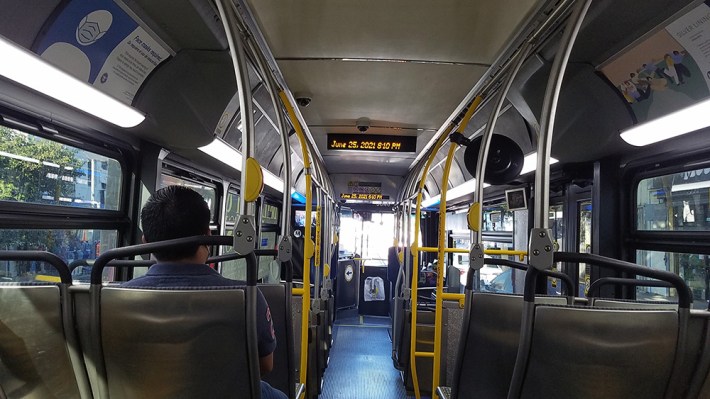
Continuing up Western, the former Hollywood Tropicana mud wrestling venue sits as an empty shell, one former gas station has found adaptive reuse as a drive-thru Starbucks and another is now a multi-story apartment development. It was here where, until the 2000s, the 175 made a right turn on Fountain Avenue, becoming that bus that seemingly came out of the horizon to my tweenage/teenage eyes.
Fountain Avenue hasn’t visually changed that much over the years, being a mostly-residential thoroughfare of mostly Armenian, Latin American and Filipino immigrant family households, peppered with sparse commercial frontages and concentrations of convalescent facilities towards Western and medical-related institutions near Vermont. The imposing blue edifice that houses Church of Scientology’s western headquarters also sits on Fountain along the old 175 route, itself formerly the Cedars of Lebanon Hospital from 1930 to 1976, before it moved west to Beverly Hills to become today’s Cedars-Sinai Medical Center.
On the warm, smoggy morning of Thursday, October 1, 1987, I walked up Edgemont Street on my way to the 175 stop on Fountain, listening to The System’s Don’t Disturb This Groove cassette through the headphones on my Sony Walkman stereo. Not long after I reached the bus stop, the sight and sound of dozens of pigeons suddenly taking off into the sky filled the corner of my eye – an odd sight. But within seconds, I heard the rattling of security gates from the still-closed storefronts and the even stranger sight of Fountain Avenue rolling like waves on the sea and the uneasy sensation of being on a boat on that rolling sea. “Get away from the building!” one of the students at the bus stop yelled.
It took a few seconds to realize – it was an earthquake.
It was there while waiting for the 175 that this native Angeleno experienced his very first earthquake – an unforgettable magnitude 5.9 in fact, centered over 15 miles away in the Whittier Narrows area.
But the 175 bus on its final day continued up Western, turning right at Sunset Boulevard, where a new (and once seemingly forever under-construction) Target department store stands, formerly a shopping plaza that housed a Carl’s Jr, a Sav-on drugstore, an Alpha Beta supermarket and The Wherehouse record store where teenage me bought countless records, cassettes and 45s, and my dad rented numerous movies - on Beta videocassette format. Also at Sunset and Western stood the recently-closed Food 4 Less supermarket, which was a Zody’s department store during my junior high days.
The other passenger on the bus wanted to alight at Sunset and Western, but the operator somehow missed his Stop Request and eventually let him out two blocks away. A potential third rider banged on the door in futility after it closed, and the bus pulled away.
The rest of Sunset Boulevard generally resembled the Sunset of my youth – the Shakey’s Pizza and Zankou Chicken are still going strong, even through the recent pandemic and its myriad protocols. My birthplace, Kaiser Permanente Los Angeles Medical Center, built in 1953, is the largest institution along the route, although the actual hospital building where I was born was demolished in 2007 to make way for a newer, state-of-the-art facility that stands over the boulevard today. On Sunset and Vermont, across from Children’s Hospital Los Angeles’ campus, is the main reason for the 175’s route realignment in 2000: a Metro B (Red) Line’s subway station. Back in The Dark Ages, unassuming single-story commercial buildings occupied the corner where the area’s major transit hub now stands. It was also here where the third passenger of the bus got on.
Continuing east on Sunset, the 175 made a turn south on Virgil Avenue at the complicated-to-say-the-least 6-way intersection where Sunset and Hollywood boulevards, Hillhurst Avenue, Sunset Drive and Virgil converge. Originally a normal 4-way intersection, it was made much more complex in 1915 when the Pacific Electric Railway line along Sunset cut through to Hollywood Boulevard, also resulting in the famous street’s extension. The Vista Theatre, the extant edifice at this intersection since 1923 and recent Quentin Tarantino acquisition, still stands proud.
The line’s short jog on Virgil took the 175 back to familiar territory, where the bus passed by The Bicycle Kitchen and stayed true to its original Fountain alignment for all of three blocks, before making a left turn at Talmadge. It was on the residential corner of Talmadge and Sunset Drive where the third passenger got off, leaving me the sole rider for the remainder of the route. It was also here where on school days, half the bus alighted and walked to King Junior High/Middle School one block east.
For the second half of my tenure on the 175, I remained on the bus, passing by The Prospect Studios, which at the time was the home of television station KABC Channel 7. It was here where news anchor Jerry Dunphy wished viewers, “From the desert to the sea, to all of Southern California, a good evening” and the whimsical and charismatic Dr. George Fischbeck made his iconic and entertaining weather forecasts.
As the bus headed north on Talmadge, the style of single-family homes transitioned to a slightly higher income bracket, especially north of Franklin Avenue. The 175 made a right turn on Tracy Street in Los Feliz, in an area now referred to as Franklin Hills, where Mediterranean-style homes hug the tree-heavy topography. Before it was known as a hipster neighborhood, the Los Feliz of my high school days was more known for its elderly population. As the street bends, the 1930 Collegiate Gothic-styled edifice of my alma mater, John Marshall High School, appeared on the left side. The school’s characteristic tower and façade has been featured on countless motion pictures, television shows, commercials and music videos - it even has its own IMDB page. The school’s alumni includes Judge Lance Ito, Heidi Fleiss, Leonardo DiCaprio (although he didn’t actually graduate), Julie Newmar and the late L.A. City Councilmember Tom LaBonge – indisputably Marshall High’s most outspoken alumnus.
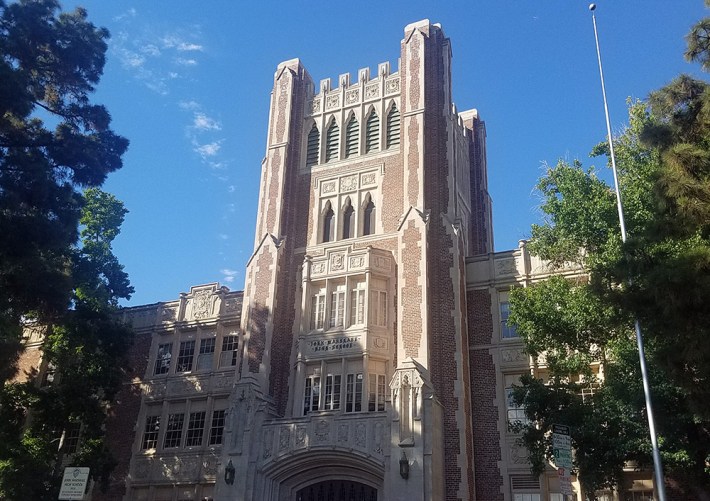
At Tracy and St. George streets, at the very stop where I disembarked from the 175 every morning, the operator got on the bus’ public address system and said, “Attention passengers…[followed by unintelligible words]…a few minutes.” I assumed the bus, ahead of schedule, dwelled at the stop to sync up with its timetable. It also gave me a few minutes to reflect at the sight of my old school for a bit. Although I was never one who felt my life peaked during high school, the familiar sight of the campus, the appearance of which remained virtually the same as when I attended there, gave me a sense of comfort and familiarity. When the bus finally moved again, the unfamiliar sight of the massively remodeled football field and athletic track at the back of the campus caught me by surprise.
The bus made a right turn at Griffith Park Boulevard, passing by the Gelson’s Market on Hyperion Avenue. During my high school days, it was a Mayfair Market, and when the high school was built, the lot was home of the Walt Disney Studios, until Mickey & company moved to Burbank in 1940. Another right turn onto Hyperion, the 175 rushed through the meandering curves of the street, finding its way to Silver Lake’s Sunset Junction area, named after the convergence of Red Car lines that met there until 1954. During my school days, I usually got home by riding the 175 to its terminus at Sunset and Sanborn and transferring to the westbound 4 bus to Santa Monica Boulevard. Today’s hypergentrified Sunset Junction of hipster coffeeshops and artisanal/bespoke/vintage retail storefronts galore contrasted with the more humble layout of laundromats, gay bars and bookstores, mom-and-pop shops and the still-standing Army surplus store back in the ‘80s. The 175 made its last turn from Sunset onto Sanborn Avenue, stopping in the layover zone.
I bid a “Thank you” to the operator and stepped off the 175 for the very last time in my life.
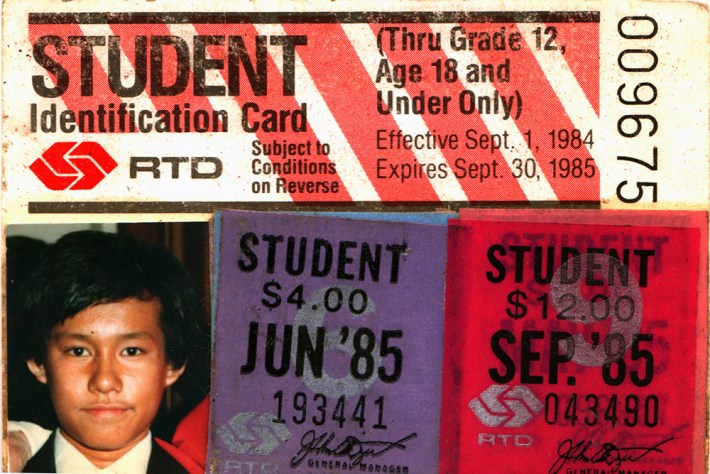
The monthly student bus pass wasn’t always $4; in 1985 it tripled in price to $12 and grew incrementally over the years to $18 when I was a senior in high school. But possessing the RTD bus pass gave me an opportunity to explore the city beyond the 175 commute; on certain days I took the 2 or 3 bus along Sunset to buy records or cassettes at the aforementioned Wherehouse near Western or the Music Plus on Vine Street. As a fledgling musician at the time, I took the 2 to the flagship Guitar Center store near Gardner Street.
During one Shortened Day in the 8th grade, a friend and I rode the 4 bus after school to the old Nadine’s Music at Santa Monica and Vine just to play with synthesizers and drum machines. The store staff kicked us out, assuming we were truants.
During summer vacation, I even got to explore this seemingly uncharted domain known as downtown L.A. I was an RTD student bus pass holder all the way to my sophomore year in college, and got to explore downtown and beyond (even traveling as far as Brea in Orange County via bus) when I attended Cal State L.A. and USC in the early ‘90s. Though I own and drive a car today, I still ride Metro’s trains and/or buses regularly to work or wherever practical. By the time The Dark Ages ended, and rail lines sprang throughout L.A. County, I already had a head start compared to the transit newbies of the time, and it was all because of the 175.
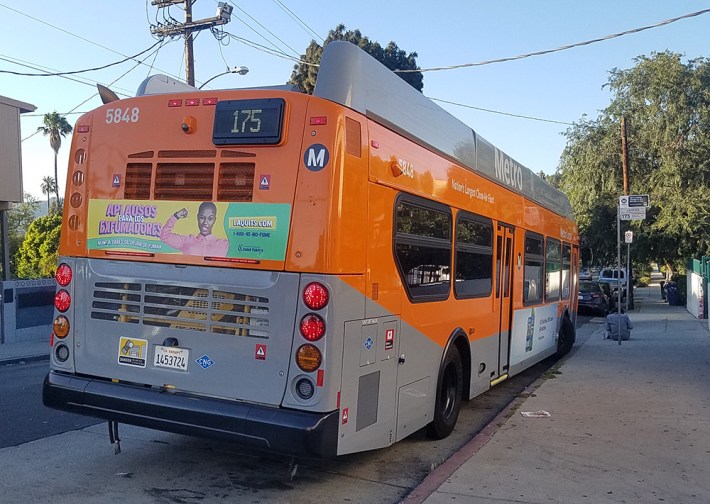
The 175 wasn’t the only June 27 transit casualty from my youth; the also-discontinued 201, which ran through Silver Lake into Glendale, is what took my first girlfriend and me to our very first date at the Glendale Galleria in 1986, as well as taking me to various friends’ houses in Silver Lake.
But as the old adage goes, the only constant is change. The 175 was born during a period of bus system restructuring, and met its demise as a result of a similar restructuring. A portion of the 175, from Sunset and Vermont to Griffith Park and Hyperion, now lives on as Line 182, which stretches further east towards Highland Park and El Sereno.
I couldn’t help but imagine another wide-eyed youngster headed to middle school this August discovering transit for the first time via this new line, and the cycle begins anew.
Born and raised in Los Angeles, Elson Trinidad is a writer who has contributed to Streetsblog L.A., KCET and the Los Angeles Times. He is also an accomplished singer/musician, community organizer, historian, and nonprofit professional. Find more on him at his website and on Twitter.
